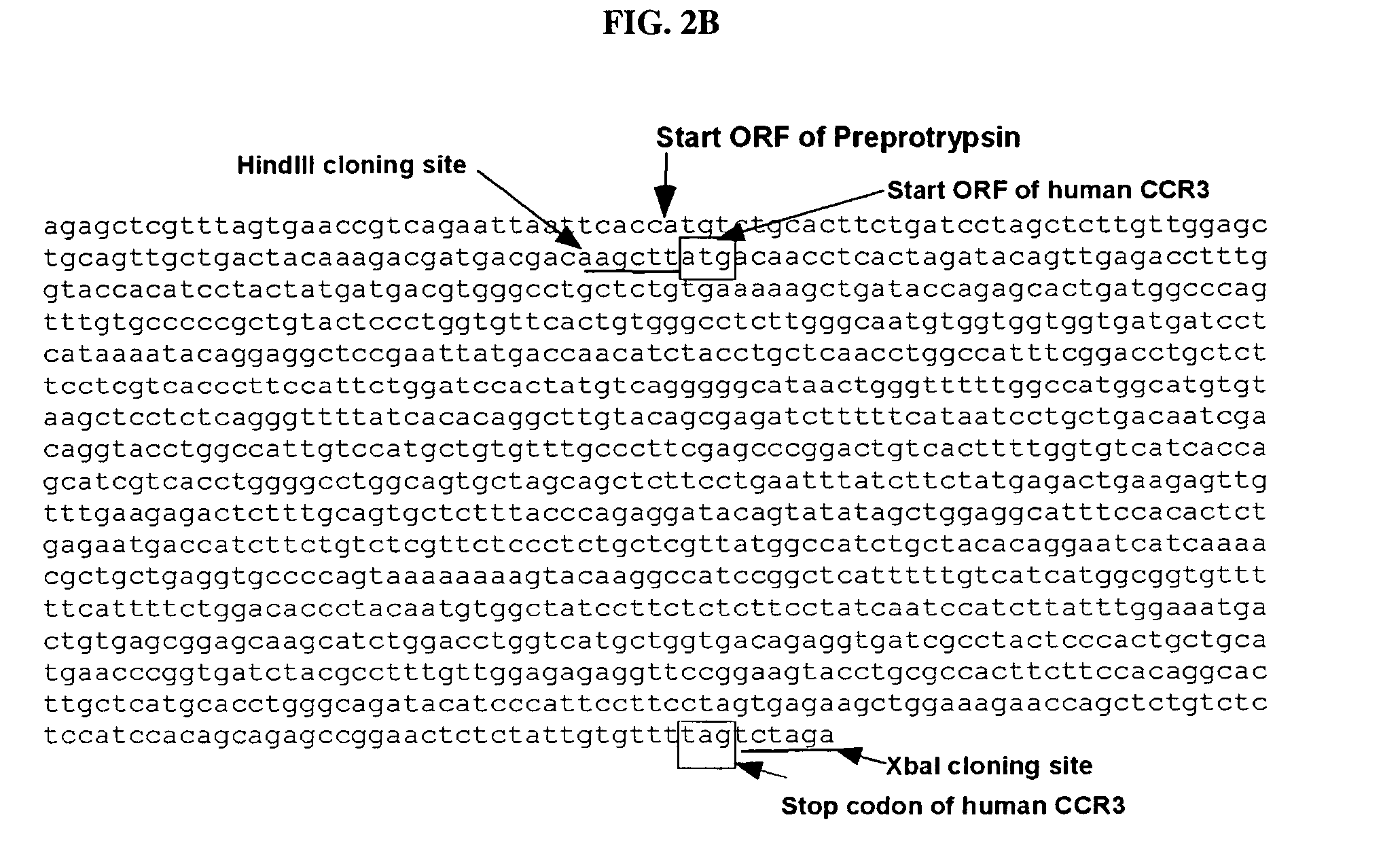Polynucleotides encoding chimeric chemokine receptors
a technology of chimeric chemokine receptors and polynucleotides, which is applied in the field of chimeric proteins, can solve the problems of enormous complexity of possible interactions
- Summary
- Abstract
- Description
- Claims
- Application Information
AI Technical Summary
Benefits of technology
Problems solved by technology
Method used
Image
Examples
example 1
Cloning Wildtype CCR3 from Human Monocytes
[0174]The sequences used to generate PCR primers for cloning the endogenous CCR3 receptor of human eosinophils was based upon nucleic acid sequences of Combadiere et al. (Combadiere et al., (1995) J. Biol. Chem. 270 (27) 16491-16494; Accession No. U28694). The PCR primers listed below; however were used to clone CCR3 from a human monocyte cDNA library and not from eosinophils. The CCR3 receptor was cloned in overlapping halves that were then joined by PCR overlap ligation reaction as described by Peiper et al. (Peiper et al., (1997) Method Enzymol. 288:56-70). The primers used were as follows:
[0175]
5′ CCR3 (EcoRI site in lowercase):5′ CGgaattcATGACAACCTCACTAGATACA 3′(SEQ ID NO:7)3′ CCR3 midway:5′ GGACAATGGCCACCTACC 3′(SEQ ID NO:8)5′ CCR3 midway:5′ GCATGTGTAAGCTCCTCTC 3′(SEQ ID NO:9)3′ CCR3 (XbaI site in lowercase):5′ GCtctagaCTAAAACACAATAGAGAGTTCC(SEQ ID NO:10)
[0176]The 5′ and 3′ PCR products were purified and joined as indicated above to yi...
example 2
Cloning Wild-type CCR2B from Human Monocytes
[0177]The sequences used to obtain PCR primers for the purpose of cloning the human CCR2 isoform B (CCR2B) receptor were based upon the 1994 publication of Charo et al. (Charo et al., (1994) Proc. Natl. Acad. Sci. U.S.A. 91(7) 2752-2756 GenBank Accession No. U03905). The sequence of the primer used to amplify CCR2B at its 5′ end was CGGggtaccATGCTGTCCACATCTCGTTCT (SEQ ID NO:11; an introduced KpnI restriction site is indicated by lowercase letters). The sequence of the primer used to amplify CCR2B at its 3′ end was CGGggtaccTCCTCGTTTTATAAAACCAGCC (SEQ ID NO:12; an introduced KpnI restriction site is indicated by lowercase letters). The full-length CCR2B cDNA was amplified from a human monocyte cDNA library. The resulting PCR product was digested with KpnI and cloned into the KpnI site located within the multiple cloning site (MCS) of the pFLAG CMV-1 (FIG. 2A).
example 3
Assembling A Chimeric CCR3 / 2 Receptor cDNA Clone
[0178]As noted above, cDNAs for human chemokine receptors CCR3 and CCR2B were cloned from a monocyte cDNA library. Overlapping PCR products consisting of the human CCR3 gene from the N-terminus through the seventh transmembrane domain and the human CCR2B gene from the seventh transmembrane domain through the C-terminus were spliced together as described below.
[0179]Using pFLAG-CMV1 / CCR3 as a template, the following primers were used to amplify a partial CCR3 cDNA encompassing the START codon (in bold) through the seventh transmembrane domain:
[0180]
5′ primer:CCCAaagcttATGACAACCTCACTAGATAC(SEQ ID NO:13)(HindIII site in smallcase)3′ primer:GCaatattTCCGGAACCTCTCTCCAAC(SEQ ID NO:14)(blunt-end SspI site in smallcase)
[0181]Using pFLAG-CMV1 / CCR2B as a template, the following primers were used to amplify a partial CCR2B cDNA encompassing the seventh transmembrane domain through the STOP codon (reverse sequence in bold):
[0182]
5′ primer:GGGatatct...
PUM
| Property | Measurement | Unit |
|---|---|---|
| concentration | aaaaa | aaaaa |
| width | aaaaa | aaaaa |
| TM | aaaaa | aaaaa |
Abstract
Description
Claims
Application Information
 Login to View More
Login to View More - R&D
- Intellectual Property
- Life Sciences
- Materials
- Tech Scout
- Unparalleled Data Quality
- Higher Quality Content
- 60% Fewer Hallucinations
Browse by: Latest US Patents, China's latest patents, Technical Efficacy Thesaurus, Application Domain, Technology Topic, Popular Technical Reports.
© 2025 PatSnap. All rights reserved.Legal|Privacy policy|Modern Slavery Act Transparency Statement|Sitemap|About US| Contact US: help@patsnap.com



